An Alternative Approach to Overcome the Limitation of HRUs in Analyzing Hydrological Processes Based on Land Use/Cover Change
Abstract
:1. Introduction
2. Study Site and Materials
2.1. Study Area
2.2. Materials
3. Methods
3.1. Land Use/Cover Change
3.2. SWAT Model Building and Improvement
3.2.1. Base Period Model Building and Calibration
3.2.2. Modified Approach for LUCCIHP
3.3. Impact of Land Use/Cover Change on Hydrological Processes
4. Results
4.1. SWAT Model Building and Improvement
4.2. Impact of Land Use/Cover Change on Hydrological Processes
4.2.1. Variation of Total Flow at the Basin Outlet
4.2.2. Variation of Flow Components at the Sub-Basin Level
4.2.3. Spatial Distribution of Surface Runoff at the HRU Level
5. Discussion
6. Conclusions
Supplementary Materials
Acknowledgments
Author Contributions
Conflicts of Interest
References
- Vörösmarty, C.J.; Green, P.; Salisbury, J.; Lammers, R.B. Global water resources: Vulnerability from climate change and population growth. Science 2000, 289, 284–288. [Google Scholar] [CrossRef] [PubMed]
- Xia, J.; Qin, Y.; Chen, D. Water problems and opportunities in the hydrological sciences in china. Hydrol. Sci. J. 2001, 46, 907–921. [Google Scholar]
- Sivakumar, B. Water crisis: From conflict to cooperation—An overview. Hydrol. Sci. J. 2011, 56, 531–552. [Google Scholar] [CrossRef]
- Luo, M.; Meng, F.; Liu, T.; Duan, Y.; Frankl, A.; Kurban, A.; Maeyer, P.D. Multi–model ensemble approaches to assessment of effects of local climate change on water resources of the hotan river basin in Xinjiang, China. Water 2017, 9, 584. [Google Scholar] [CrossRef]
- Stocker, T.F.; Qin, D.; Plattner, G.-K.; Tignor, M.; Allen, S.K.; Bo-schung, J. Climate Change 2013: The Physical Science Basis. Contribution of Working Group i to the Fifth Assessment Report of the Intergovernmental Panel on Climate Change; IPCC: Cambridge, UK; New York, NY, USA, 2013. [Google Scholar]
- Mahmoud, S.H.; Alazba, A.A. Hydrological response to land cover changes and human activities in arid regions using a geographic information system and remote sensing. PLoS ONE 2015, 10, e0125805. [Google Scholar] [CrossRef] [PubMed]
- Woldesenbet, T.A.; Elagib, N.A.; Ribbe, L.; Heinrich, J. Hydrological responses to land use/cover changes in the source region of the upper blue nile basin, ethiopia. Sci. Total Environ. 2017, 575, 724–741. [Google Scholar] [CrossRef] [PubMed]
- Singh, R. Land use/cover changes, extreme events and ecohydrological responses in the himalayan region. Hydrol. Processes 1998, 12, 2043–2055. [Google Scholar] [CrossRef]
- Halder, S.; Saha, S.K.; Dirmeyer, P.A.; Chase, T.N.; Goswami, B.N. Investigating the impact of land-use land-cover change on indian summer monsoon daily rainfall and temperature during 1951–2005 using a regional climate model. Hydrol. Earth Syst. Sci. Discuss. 2015, 12, 6575–6633. [Google Scholar] [CrossRef]
- Bosch, J.M.; Hewlett, J.D. A review of catchment experiments to determine the effect of vegetation changes on water yield and evapotranspiration. J. Hydrol. 1982, 55, 3–23. [Google Scholar] [CrossRef]
- Chen, J.; Li, X. The impact of forest change on watershed hydrology--discussing some controversies on forest hydrology. J. Nat. Resour. 2000, 16, 474–480. [Google Scholar]
- Yao, Y.L.; Lv, X.G.; Wang, L. A review on study methods of effect of land use and land cover change on watershed hydrology. Wetland Sci. 2009, 7, 83–88. [Google Scholar]
- Zhang, C.; Zhang, B.; Li, W.; Liu, M. Response of streamflow to climate change and human activity in Xitiaoxi river basin in China. Hydrol. Processes 2014, 28, 43–50. [Google Scholar] [CrossRef]
- Liu, H.F.; Zhu, Q.K.; Sun, Z.F.; Wei, T.X. Effects of different land uses and land mulching modes on runoff and silt generations on loess slopes. Agric. Res. Arid Areas 2005, 23, 137–141. [Google Scholar]
- Zhang, X.; Zhang, L.; Zhao, J.; Rustomji, P.; Hairsine, P. Responses of streamflow to changes in climate and land use/cover in the loess plateau, China. Water Resour. Res. 2008, 44, 2183–2188. [Google Scholar] [CrossRef]
- Lørup, J.K.; Refsgaard, J.C.; Mazvimavi, D. Assessing the effect of land use change on catchment runoff by combined use of statistical tests and hydrological modelling: Case studies from zimbabwe. J. Hydrol. 1998, 205, 147–163. [Google Scholar] [CrossRef]
- Zhang, X.; Liu, Y.; Fang, Y.; Liu, B.; Xia, D. Modeling and assessing hydrologic processes for historical and potential land-cover change in the duoyingping watershed, southwest China. Phys. Chem. Earth Parts A/B/C 2012, 53–54, 19–29. [Google Scholar] [CrossRef]
- Schmalz, B.; Kuemmerlen, M.; Kiesel, J.; Cai, Q.; Jähnig, S.C.; Fohrer, N. Impacts of land use changes on hydrological components and macroinvertebrate distributions in the poyang lake area. Ecohydrology 2014, 8, 1119–1136. [Google Scholar] [CrossRef]
- Wilson, C.O.; Weng, Q. Simulating the impacts of future land use and climate changes on surface water quality in the Des Plaines River watershed, Chicago Metropolitan Statistical Area, Illinois. Sci. Total Environ. 2011, 409, 4387–4405. [Google Scholar] [CrossRef] [PubMed]
- Maalim, F.K.; Melesse, A.M.; Belmont, P.; Gran, K.B. Modeling the impact of land use changes on runoff and sediment yield in the le sueur watershed, minnesota using geowepp. Catena 2013, 107, 35–45. [Google Scholar] [CrossRef]
- López-Moreno, J.I.; Zabalza, J.; Vicente-Serrano, S.M.; Revuelto, J.; Gilaberte, M.; Azorin-Molina, C.; Morán-Tejeda, E.; García-Ruiz, J.M.; Tague, C. Impact of climate and land use change on water availability and reservoir management: Scenarios in the Upper Aragon River, Spanish Pyrenees. Sci. Total Environ. 2014, 493, 1222–1231. [Google Scholar] [CrossRef] [PubMed]
- Liu, T.; Fang, H.; Willems, P.; Bao, A.; Chen, X.; Veroustraete, F.; Dong, Q. On the relationship between historical land—Use change and water availability: The case of the lower Tarim River region in northwestern China. Hydrol. Process. 2013, 27, 251–261. [Google Scholar] [CrossRef]
- Pai, N.; Saraswat, D. Swat2009_luc: A tool to activate the land use change module in swat 2009. Trans. ASABE 2011, 54, 1649–1658. [Google Scholar] [CrossRef]
- Yan, B.; Fang, N.F.; Zhang, P.C.; Shi, Z.H. Impacts of land use change on watershed streamflow and sediment yield: An assessment using hydrologic modelling and partial least squares regression. J. Hydrol. 2013, 484, 26–37. [Google Scholar] [CrossRef]
- Baker, T.J.; Miller, S.N. Using the soil and water assessment tool (swat) to assess land use impact on water resources in an east African watershed. J. Hydrol. 2013, 486, 100–111. [Google Scholar] [CrossRef]
- Arnold, J.; Kiniry, J.; Srinivasan, R.; Williams, J.; Haney, E.; Neitsch, S. Swat 2012 Input/Output Documentation; Texas Water Resources Institute: College Station, TX, USA, 2013. [Google Scholar]
- Arnold, J.G.; Gassman, P.W.; White, M.J. New Developments in the Swat Ecohydrology Model. In Proceedings of the Century Watershed Technology: Improving Water Quality and Environment Conference, Universidad Earth, Costa Rica, 21–24 February 2010. [Google Scholar]
- Her, Y.; Frankenberger, J.; Chaubey, I.; Srinivasan, R. Threshold effects in hru definition of the soil and water assessment tool. Trans. ASABE 2015, 58, 367–378. [Google Scholar]
- Jansen, L.J.M.; Gregorio, A.D. Parametric land cover and land-use classifications as tools for environmental change detection. Agric. Ecosyst. Environ. 2002, 91, 89–100. [Google Scholar] [CrossRef]
- Anderson, J.R.; Hardy, E.E.; Roach, J.T.; Witmer, R.E. Land Use and Land Cover Classification Systems for Use with Remote Sensor Data; US Geological Service: Washington, DC, USA, 1976.
- Witmer, R.E. USGS Land Use and Land Cover Classification System; PB-US National Technical Information Service: Alexandria, VA, USA, 1978. [Google Scholar]
- Bossard, M.; Feranec, J.; Otahel, J. Corine Land Cover Technical Guide; European Environmental Agency. ETC/LC, European Topic Centre on Land Cover: Vienna, Austria, 1994; pp. 633–638. [Google Scholar]
- Liu, J.; Zhang, Z.; Xu, X.; Kuang, W.; Zhou, W.; Zhang, S.; Li, R.; Yan, C.; Yu, D.; Wu, S.; et al. Spatial patterns and driving forces of land use change in China during the early 21st century. J. Geogr. Sci. 2010, 20, 483–494. [Google Scholar] [CrossRef]
- Montenegro, S.; Ragab, R. Impact of possible climate and land use changes in the semi arid regions: A case study from north eastern Brazil. J. Hydrol. 2012, 434–435, 55–68. [Google Scholar] [CrossRef]
- Shi, X.; Li, Y.; Yan, D.; Zhao, K. Advances in the impacts of watershed land use/cover change on hydrological processes. Res. Soil Water Conserv. 2013, 20, 301–308. [Google Scholar]
- Mamillapalli, S.; Srinivasan, R.; Arnold, J.G.; Engel, B.A. Effect of spatial variability on basin scale modeling. In Proceedings of the Third International Conference/Workshop on Integrating GIS and Environmental Modeling, Santa Fe, NM, USA, 21–25 January 1996. [Google Scholar]
- Bingner, R.L.; Garbrecht, J.; Arnold, J.G.; Srinivasan, R. Effect of watershed subdivision on simulation runoff and fine sedment yield. Trans. Asae 1997, 40, 1329–1335. [Google Scholar] [CrossRef]
- Meng, F.; Liu, T.; Huang, Y.; Luo, M.; Bao, A.; Hou, D. Quantitative detection and attribution of runoff variations in the Aksu River Basin. Water 2016, 8, 338. [Google Scholar] [CrossRef]
- Zhang, S.; Liu, S.; Mo, X.; Shu, C.; Sun, Y.; Zhang, C. Assessing the impact of climate change on potential evapotranspiration in Aksu River Basin. J. Geogr. Sci. 2011, 21, 609–620. [Google Scholar] [CrossRef]
- Zhou, D.C.; Luo, G.P.; Yin, C.Y.; Xu, W.Q.; Feng, Y.X. Land use/cover change of the Aksu River watershed in the period of 1960–2008. J. Glaciol. Geocryol. 2010, 32, 275–284. [Google Scholar]
- Xu, J.; Chen, Y.; Lu, F.; Li, W.; Zhang, L.; Hong, Y. The nonlinear trend of runoff and its response to climate change in the Aksu River, western China. Int. J. Climatol. 2011, 31, 687–695. [Google Scholar] [CrossRef]
- Zhao, Q.; Ye, B.; Ding, Y.; Zhang, S.; Yi, S.; Wang, J.; Shangguan, D.; Zhao, C.; Han, H. Coupling a glacier melt model to the variable infiltration capacity (vic) model for hydrological modeling in north-western China. Environ. Earth Sci. 2012, 68, 87–101. [Google Scholar] [CrossRef]
- Song, X.; Yang, G.; Yan, C.; Duan, H.; Liu, G.; Zhu, Y. Driving forces behind land use and cover change in the Qinghai-Tibetan plateau: A case study of the source region of the yellow river, Qinghai province, China. Environ. Earth Sci. 2009, 59, 793–801. [Google Scholar] [CrossRef]
- Nunes, C.; Augé, J. Land-use and land-cover change (lucc): Implementation strategy. IGBP Rep. 1999, 48, 125. [Google Scholar]
- Dahe, Q.; Shiyin, L.; Peiji, L. Snow cover distribution, variability, and response to climate change in western China. J. Clim. 2006, 19, 1820–1833. [Google Scholar] [CrossRef]
- Sorg, A.; Bolch, T.; Stoffel, M.; Solomina, O.; Beniston, M. Climate change impacts on glaciers and runoff in Tien Shan (central Asia). Nat. Clim. Chang. 2012, 2, 725–731. [Google Scholar] [CrossRef]
- Zhang, X.; Yang, D.; Xiang, X.; Huang, X. Impact of agricultural development on variation in surface runoff in arid regions: A case of the Aksu River Basin. J. Arid Land 2012, 4, 399–410. [Google Scholar] [CrossRef]
- Arnold, J.G.; Srinivasan, R.; Muttiah, R.S.; Williams, J.R. Large area hydrologic modeling and assessment part i: Model development. JAWRA J. Am. Water Resour. Assoc. 1998, 34, 73–89. [Google Scholar] [CrossRef]
- Abbaspour, K.; Rouholahnejad, E.; Vaghefi, S.; Srinivasan, R.; Yang, H.; Kløve, B. A continental-scale hydrology and water quality model for europe: Calibration and uncertainty of a high-resolution large-scale swat model. J. Hydrol. 2015, 524, 733–752. [Google Scholar] [CrossRef]
- Marino, S.; Hogue, I.B.; Ray, C.J.; Kirschner, D.E. A methodology for performing global uncertainty and sensitivity analysis in systems biology. J. Theor. Biol. 2008, 254, 178–196. [Google Scholar] [CrossRef] [PubMed]
- Rice, J.A. Mathematical Statistics and Data Analysis; Nelson Education: Ontario, Canada, 2006. [Google Scholar]
- Nash, J.E.; Sutcliffe, J.V. River flow forecasting through conceptual models part i—A discussion of principles. J. Hydrol. 1970, 10, 282–290. [Google Scholar] [CrossRef]
- Haan, C.T.; Johnson, H.P.; Brakensiek, D.L. Hydrologic modeling of small watersheds. Am. Soc. Agric. Eng. 1970, 10, 282–290. [Google Scholar]
- Moriasi, D.N.; Arnold, J.G.; Van Liew, M.W.; Bingner, R.L.; Harmel, R.D.; Veith, T.L. Model evaluation guidelines for systematic quantification of accuracy in watershed simulations. Trans. Asabe 2007, 50, 885–900. [Google Scholar] [CrossRef]
- Bryant, R.B.; Gburek, W.J.; Veith, T.L.; Hively, W.D. Perspectives on the potential for hydropedology to improve watershed modeling of phosphorus loss. Geoderma 2006, 131, 299–307. [Google Scholar] [CrossRef]
- Tao, H.; Borth, H.; Fraedrich, K.; Su, B.; Zhu, X. Drought and wetness variability in the Tarim River Basin and connection to large-scale atmospheric circulation. Int. J. Climatol. 2014, 34, 2678–2684. [Google Scholar] [CrossRef]
- Bronstert, A.; Niehoff, D.; Bürger, G. Effects of climate and land–use change on storm runoff generation: Present knowledge and modelling capabilities. Hydrol. Process. 2002, 16, 509–529. [Google Scholar] [CrossRef]
- Haregeweyn, N.; Tesfaye, S.; Tsunekawa, A.; Tsubo, M.; Meshesha, D.T.; Adgo, E.; Elias, A. Dynamics of land use and land cover and its effects on hydrologic responses: Case study of the Gilgel Tekeze catchment in the highlands of Northern Ethiopia. Environ. Monit. Assess 2015, 187, 4090. [Google Scholar] [CrossRef] [PubMed]
- Romanowicz, A.A.; Vanclooster, M.; Rounsevell, M.; La Junesse, I. Sensitivity of the swat model to the soil and land use data parametrisation: A case study in the Thyle catchment, Belgium. Ecol. Model. 2005, 187, 27–39. [Google Scholar] [CrossRef]

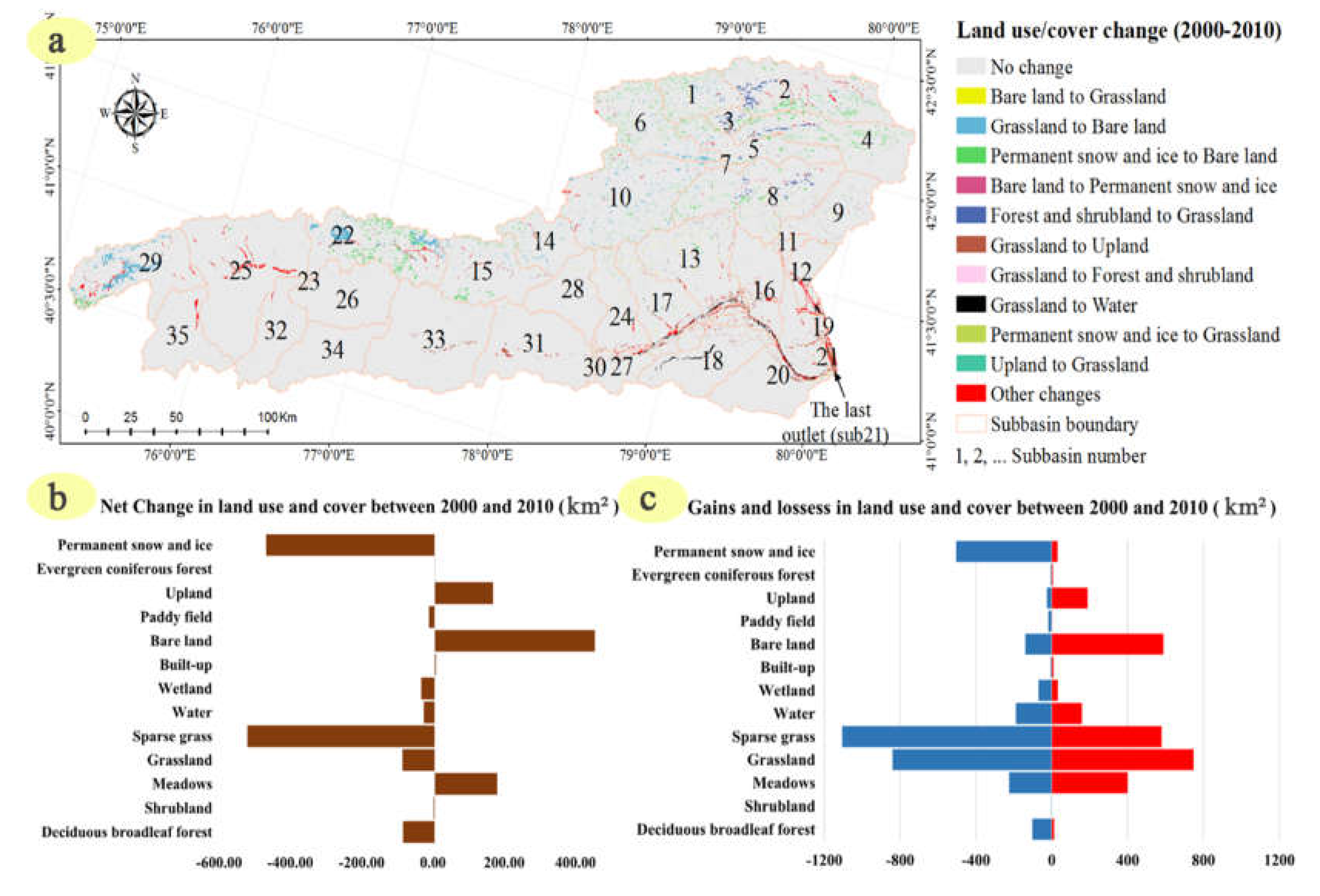
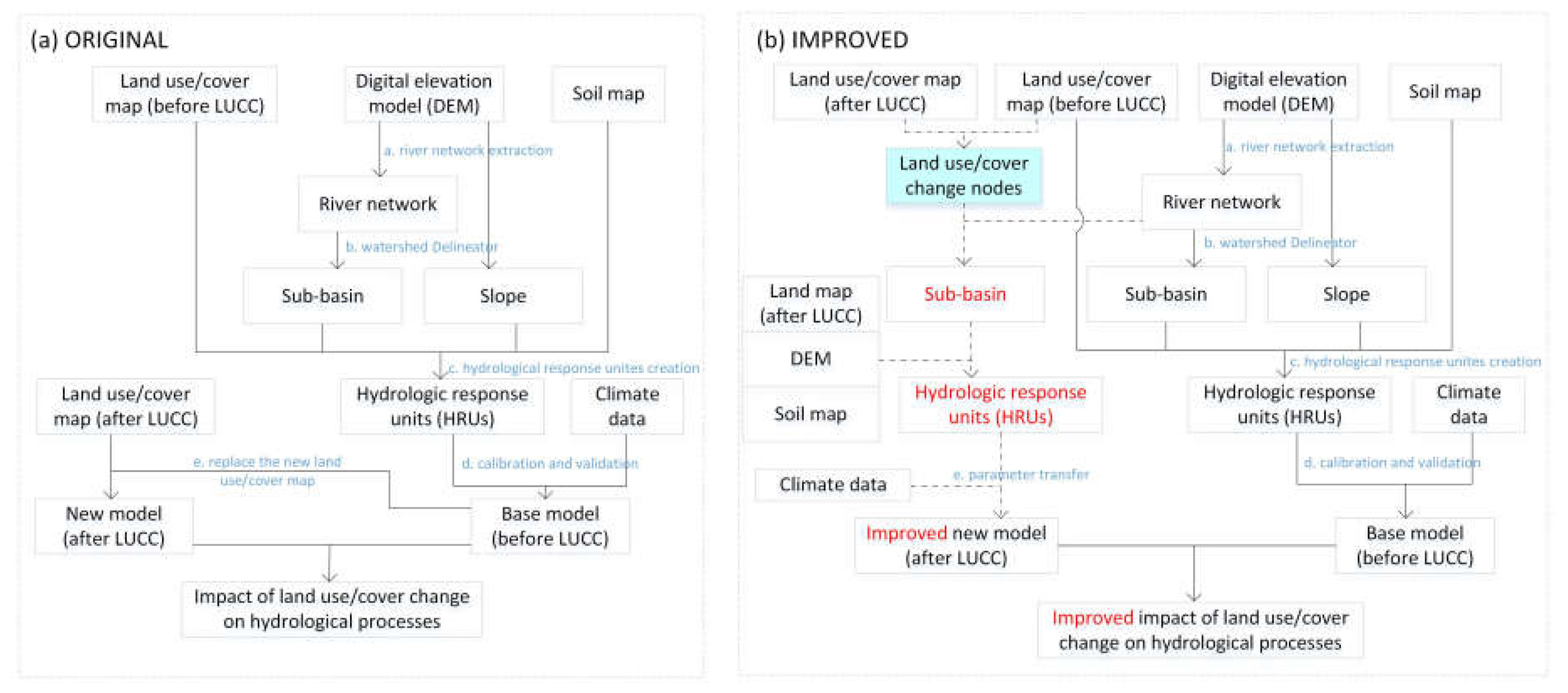


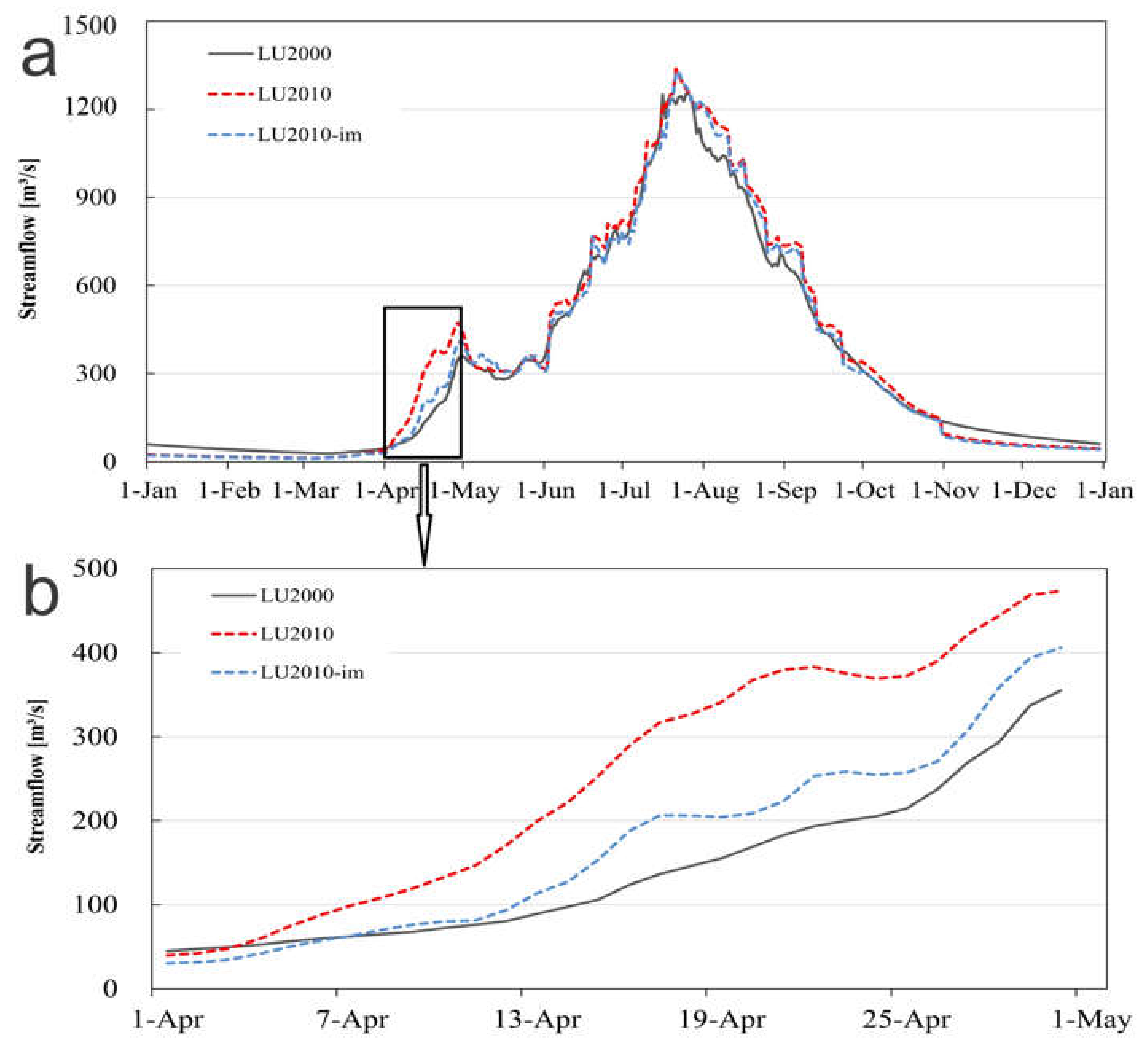
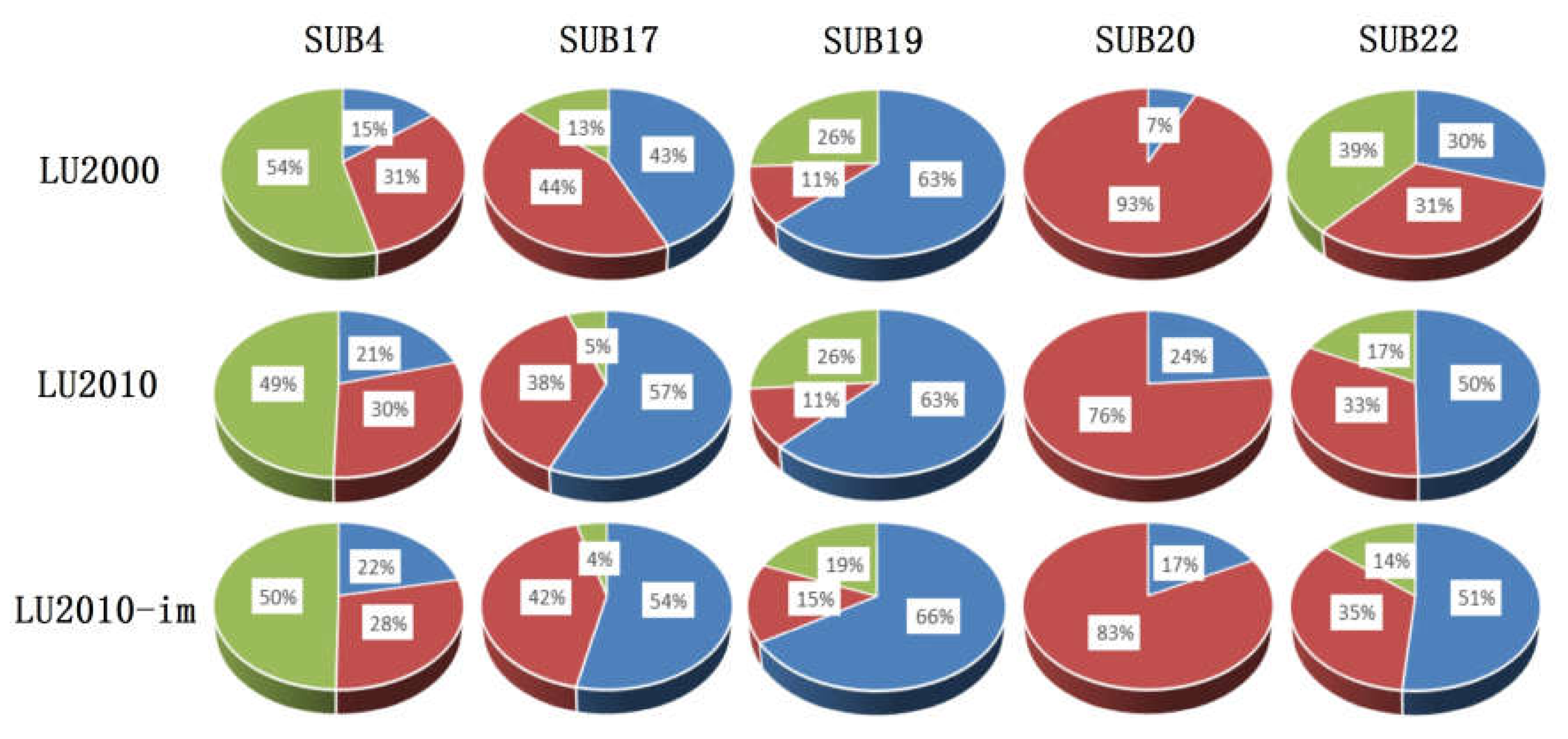

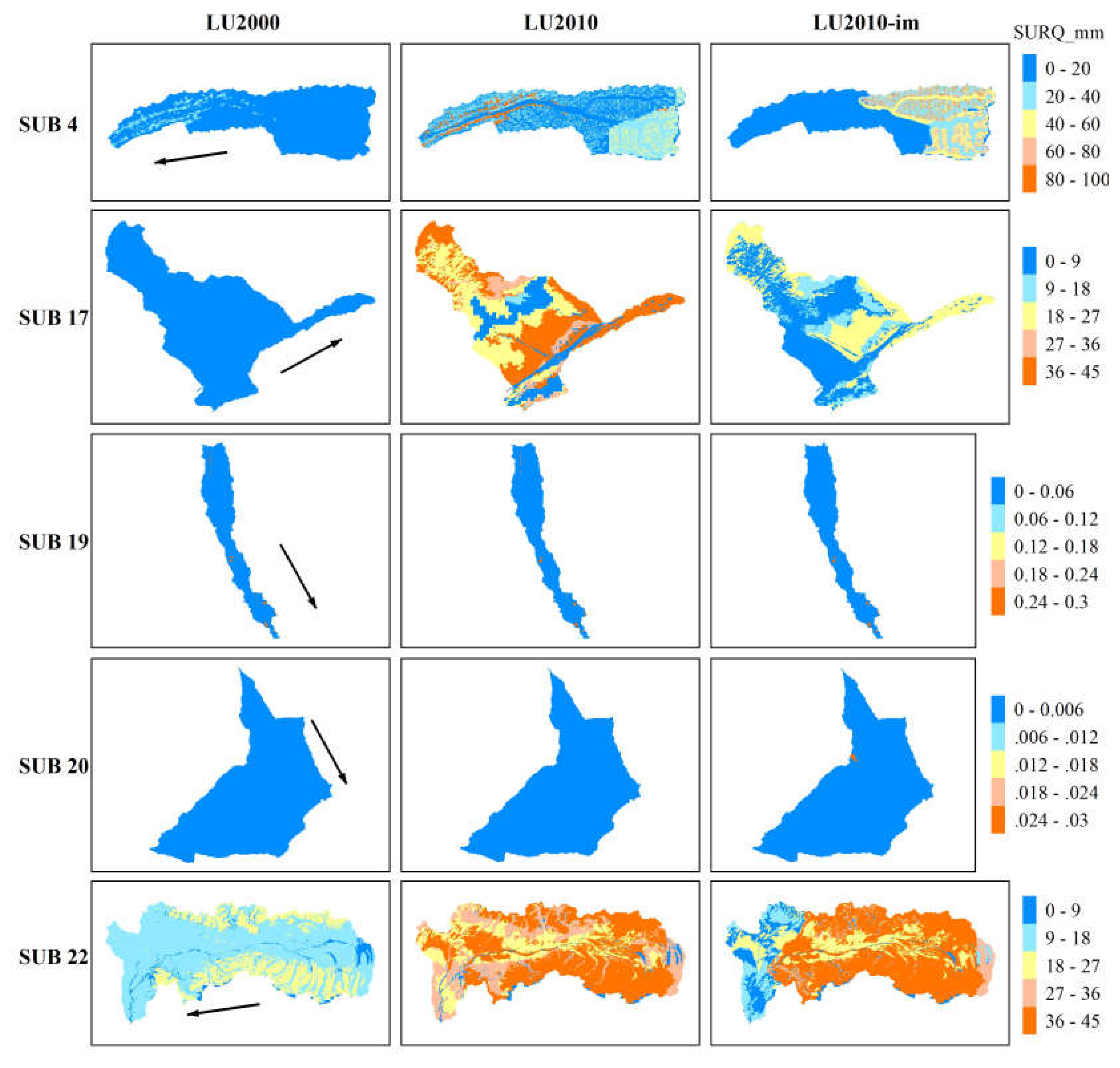
| Study | Approach to LUCCIHP | Model/Minimum Unit/Temporal Resolution | Location/Size of Watershed/Spatial Resolution | Main Output with Regard to Research Scale/Hydrology Elements/(in Relation to the Three Aims of This Study) |
|---|---|---|---|---|
| 1. Zhang et al., 2014 [13] | Watershed water balance principle | No model/n.r./n.r. | China/1320 km2/n.r. | Catchment scale/Streamflow (a, c) |
| 2. Lørup et al., 1998 [16] | Statistical approach | Lumped conceptual model—NAM/Watershed/Daily | Zimbabwe/3507 km2/1:1000000 | Catchment scale/Streamflow/(a, c) |
| 3. Zhang et al., 2012 [17] | Replace land use/land cover (LULC) data directly | Fully distributed hydrological model—VIC/Grid/Monthly | Southwest China/8599 km2/1 km | Grid scale/Runoff, ET, Soil moisture/(a, c) |
| 4. Liu et al., 2013 [22] | Enlarge farmland surface areas | Fully distributed hydrological model—MIKE SHE/Grid/Daily | Northwestern China/< 10,000 km2/5 km | Catchment scale/Surface water resources, groundwater storage/(c) |
| 5. Maalim et al., 2013 [20] | Replace LULC data directly | Semi-distributed hydrological model—GeoWEPP/HRU/Yearly | Minnesota, USA/2880 km2/30 m | HRU scale/Runoff depth, soil loss rate and sediment delivery ratio/(c) |
| 6. López-Moreno et al., 2014 [21] | Replace two land cover scenarios maps | Semi-distributed hydrological model—RHESSys/HRU/Monthly | Spanish Pyrenees/2181 km2/1 km | Catchment scale/Streamflow/(c) |
| 7. Baker et al., 2013 [25] | Replace three LULC scenarios | Semi-distributed hydrological model—SWAT/HRU/monthly | East Africa/272 km2/50 m | Sub-basin scale/Surface runoff, groundwater recharge/(c) |
| 8. Woldesenbet et al., 2017 [7] | Replace three LULC data directly | Semi-distributed hydrological model—SWAT/HRU/monthly | Ethiopia/15,000 km2/90 m | Sub-basin scale/Surface runoff, actual evapotranspiration/(a, c) |
| 9. Schmalz et al., 2014 [18] | Replace five LULC scenarios | Semi-distributed hydrological model—SWAT/HRU/Daily | China/6260 km2/90 m | Sub-basin scale and HRU scale/Surface runoff, groundwater flow/(a, c) |
| 10. N. Pai and D. Saraswat, 2007 [23] | Replace three LULC data automatically | Semi-distributed hydrological model—SWAT/HRU/Daily | Arkansas/1963 km2/n.r. | Sub-basin scale and HRU scale/Streamflow/(a, c) |
| 11. This study | Analyze LUCC for sub-basin segmentation and replace LULC data | Semi-distributed hydrological model—SWAT/HRU/Daily | China/42,900 km2/90 m | Catchment scale, sub-basin scale and HRU scale/Streamflow, surface runoff, lateral flow, groundwater flow/(a, b, c) |
| Component | Parameter Name | Description | Sensitivity Rate | Calibration Range | Sub-Basin | Final Estimate Value |
| Basin/snow | SFTMP | Snowfall temperature | 4 | −5~5 | Share | −0.552 |
| SMTMP | Snow melt base temperature | 1 | −5~5 | Share | −0.2478 | |
| SMFMX | Melt factor for snow on 21 June | 7 | 0~10 | Share | 6.8002 | |
| SMFMN | Melt factor for snow on 21 December | 10 | 0~10 | Share | 1.5104 | |
| TIMP | Snow pack temperature lag factor | 8 | 0.01~1 | Share | 0.0873 | |
| PLAPS | Precipitation lapse rate | 2 | 0~500 | SLGLK | 70 | |
| XHL | 280 | |||||
| TLAPS | Temperature lapse rate | 3 | −10~10 | SLGLK | −6.5 | |
| XHL | −4.5 | |||||
| Surface runoff | LAT_TTIME | Lateral flow travel time (days) | 5 | 0~180 | SLGLK | 7 |
| XHL | 3 | |||||
| CH_K2 | Effective hydraulic conductivity in main channel alluvium (mm/h) | 9 | 0~500 | SLGLK | 0.006 | |
| XHL | 0.65 | |||||
| Ground water | ALPHA_BF | Baseflow alpha factor | 6 | 0~1 | SLGLK | 0.5 |
| XHL | 1 | |||||
| Component | Parameter Name | Description | Code | Initial Value | Sub-basin | Final Estimate Value |
| Land use and land management | CN | Moisture constitution II curve number | AGRL | 87 | Share | 82 |
| FESC | 72 | Share | 71 | |||
| FRSE | 70 | Share | 70 | |||
| RNGE | 79 | Share | 78 | |||
| RNGB | 72 | Share | 73 | |||
| WATR | 92 | Share | 92 | |||
| BARR | 94 | Share | 90 | |||
| FRSD | 77 | Share | 76 | |||
| PAST | 79 | Share | 78 | |||
| RICE | 81 | Share | 80 | |||
| URLD | 85 | Share | 84 | |||
| WETN | 84 | Share | 78 |
© 2018 by the authors. Licensee MDPI, Basel, Switzerland. This article is an open access article distributed under the terms and conditions of the Creative Commons Attribution (CC BY) license (http://creativecommons.org/licenses/by/4.0/).
Share and Cite
Meng, F.; Liu, T.; Wang, H.; Luo, M.; Duan, Y.; Bao, A. An Alternative Approach to Overcome the Limitation of HRUs in Analyzing Hydrological Processes Based on Land Use/Cover Change. Water 2018, 10, 434. https://doi.org/10.3390/w10040434
Meng F, Liu T, Wang H, Luo M, Duan Y, Bao A. An Alternative Approach to Overcome the Limitation of HRUs in Analyzing Hydrological Processes Based on Land Use/Cover Change. Water. 2018; 10(4):434. https://doi.org/10.3390/w10040434
Chicago/Turabian StyleMeng, Fanhao, Tie Liu, Hui Wang, Min Luo, Yongchao Duan, and Anming Bao. 2018. "An Alternative Approach to Overcome the Limitation of HRUs in Analyzing Hydrological Processes Based on Land Use/Cover Change" Water 10, no. 4: 434. https://doi.org/10.3390/w10040434
APA StyleMeng, F., Liu, T., Wang, H., Luo, M., Duan, Y., & Bao, A. (2018). An Alternative Approach to Overcome the Limitation of HRUs in Analyzing Hydrological Processes Based on Land Use/Cover Change. Water, 10(4), 434. https://doi.org/10.3390/w10040434





